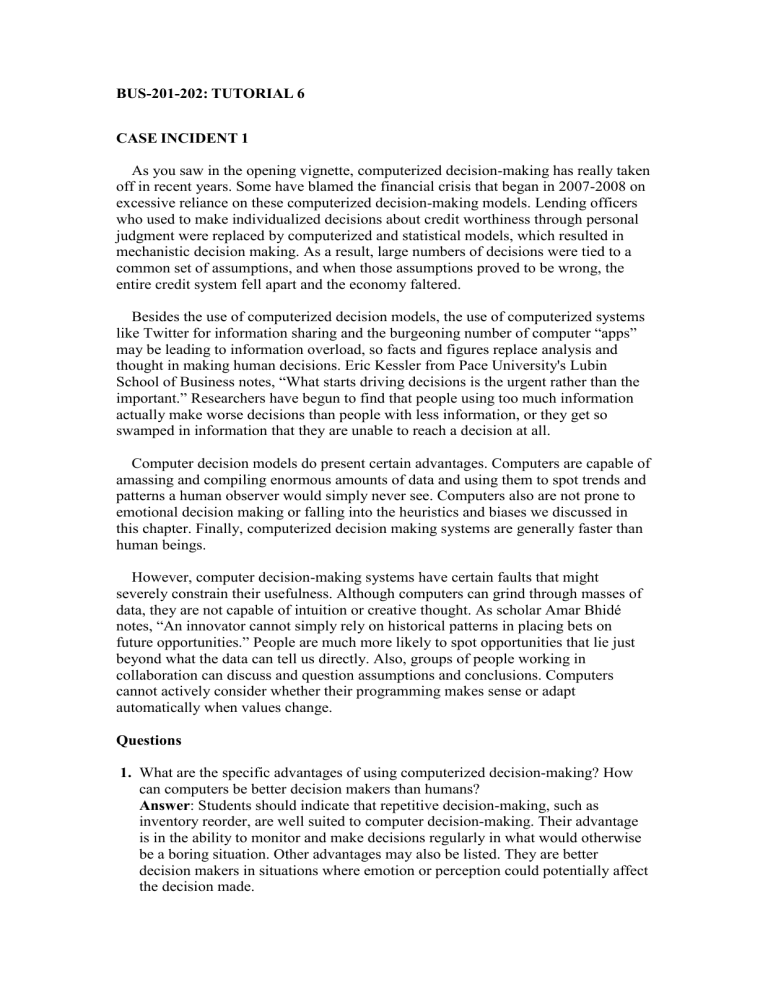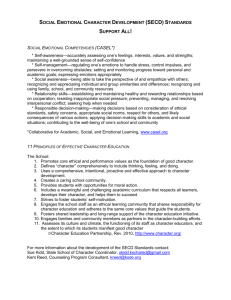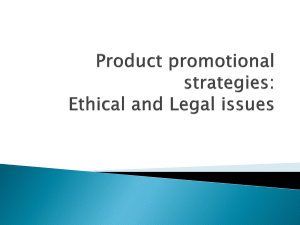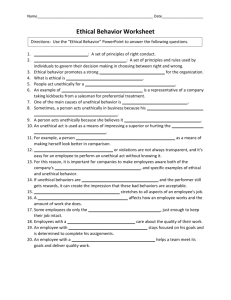BUS-201-202: TUTORIAL 6 CASE INCIDENT 1 As you saw in the

BUS-201-202: TUTORIAL 6
CASE INCIDENT 1
As you saw in the opening vignette, computerized decision-making has really taken off in recent years. Some have blamed the financial crisis that began in 2007-2008 on excessive reliance on these computerized decision-making models. Lending officers who used to make individualized decisions about credit worthiness through personal judgment were replaced by computerized and statistical models, which resulted in mechanistic decision making. As a result, large numbers of decisions were tied to a common set of assumptions, and when those assumptions proved to be wrong, the entire credit system fell apart and the economy faltered.
Besides the use of computerized decision models, the use of computerized systems like Twitter for information sharing and the burgeoning number of computer “apps” may be leading to information overload, so facts and figures replace analysis and thought in making human decisions. Eric Kessler from Pace University's Lubin
School of Business notes, “What starts driving decisions is the urgent rather than the important.” Researchers have begun to find that people using too much information actually make worse decisions than people with less information, or they get so swamped in information that they are unable to reach a decision at all.
Computer decision models do present certain advantages. Computers are capable of amassing and compiling enormous amounts of data and using them to spot trends and patterns a human observer would simply never see. Computers also are not prone to emotional decision making or falling into the heuristics and biases we discussed in this chapter. Finally, computerized decision making systems are generally faster than human beings.
However, computer decision-making systems have certain faults that might severely constrain their usefulness. Although computers can grind through masses of data, they are not capable of intuition or creative thought. As scholar Amar Bhidé notes, “An innovator cannot simply rely on historical patterns in placing bets on future opportunities.” People are much more likely to spot opportunities that lie just beyond what the data can tell us directly. Also, groups of people working in collaboration can discuss and question assumptions and conclusions. Computers cannot actively consider whether their programming makes sense or adapt automatically when values change.
Questions
1.
What are the specific advantages of using computerized decision-making? How can computers be better decision makers than humans?
Answer : Students should indicate that repetitive decision-making, such as inventory reorder, are well suited to computer decision-making. Their advantage is in the ability to monitor and make decisions regularly in what would otherwise be a boring situation. Other advantages may also be listed. They are better decision makers in situations where emotion or perception could potentially affect the decision made.
2.
What are the weaknesses of using computers as decision tools? Are computers likely to have any specific problems in making decisions that people wouldn’t have?
Answer : Weakness suggested by students could be a number of different points, but tone of the most important weaknesses is making decisions of unique situations. Students may give the example of BIG Blue, the IBM computer that played chess and competed in Jeopardy . Although Big Blue became success in competing, the effort to program AI was immense. See http://en.wikipedia.org/wiki/Deep_Blue_(chess_computer ) for a discussion.
3.
Do you think computer decision-making systems can effectively take ethical issues into account? What is the role of human decision makers in creating ethical choices?
Answer : The student might see that the example of Big Blue suggests that as
Artificial Intelligence grows in its capability, that a computer may be able to make decisions that include ethical considerations. The problem will be selecting the ethical positions to build into the computer’s AI.
4.
Are there advantages to completely disconnecting from the wired world when possible? What can you do to try to retain your ability to focus and process information deeply?
Answer : This is an opinion question for the student to respond to. As such the answer will vary widely. The answer will differ depending on the student’s selfawareness regarding many aspects of their personalities. Those with greater selfawareness will likely say that disengagement serves as an important time for the student to refresh, reorganize, and repair his or her mindset and attitudes to be more effective as a person.
Source:
Based on S. Begley, “I Can’t Think!” Newsweek 157, (March 7, 2011), www.newsweek.com
; A. Bhidé, “The Judgment Deficit” Harvard Business Review, (September,
2010), pp. 44-53; and T. H. Davenport and J. H. Snabe, “How Fast and Flexible Do You Want Your
Information, Really?” Sloan Management Review 52, (Spring 2011), pp. 57-62.
CASE INCIDENT 2
Why would former New York Attorney General and then Governor Eliot
Spitzer decide to use a prostitution service? Why would highly respected attorney
Marc Dreier, with degrees from Harvard and Yale and a successful Park Avenue law firm, decide to impersonate people in order to swindle others? From Tiger Woods to
Bernie Madoff, it’s not hard to find examples of unethical behavior. But what causes people to make unfortunate choices?
Behavioral genetics research has taught us that virtually every human characteristic has genetic origins, and that genetic differences are a central reason people differ in their behavior. Thus, some personality traits probably predispose people toward unethical behavior. One study of white-collar criminals, for example,
showed they were significantly lower on conscientiousness than the general population.
On the other hand, recent research shows that all of us perform unethical behavior to some degree while subconsciously fooling ourselves about it. We may bend a rule to help a colleague, overlook information that might damage a case we want to make, or lie to avoid a negative consequence, blithely unaware that others might view this behavior as unethical.
Why do we do this? Evidence suggests that when we fail to notice a decision has an ethical component, it enables us to behave in a self-interested manner without having to feel badly about it. No wonder, then, that people tend to believe they are more ethical than they are.
Many think that transparency and accountability increase ethical behavior.
Behavioral ethics research, however, shows us that often these actions increase unethical behavior, because they cause individuals to think disclosure absolves them of ethical responsibilities to be objective, or to deny to an even greater degree the ethical components of their decisions.
The first step toward behaving more ethically is, ironically, admitting to ourselves that we adhere to ethical standards less well than we admit.
Questions
1.
Do you think people see themselves as more ethical than they really are? And you?
Answer: A tendency to overestimate almost every part of a personality is real. Ask students to read http://www.bethedream.net/ethics.htm
and to compare their ethical standards. Students will find their answer to this question varying greatly. Some will find a great deal of similarity in beliefs with the web resource. Some will not. In fact, some students will not know what some of the elements are that the statement addresses an ethical position for.
2.
The authors of one study noted that “disclosures can exacerbate [unethical behavior] by causing people to feel absolved of their duty to be objective.” Do you agree? Why or why not?
Answer: The answer to this question will depend on the student’s ethical position. Some students will hold a very strong ethical position and will see disclosure of an ethical breach to be equal to admission of guilt in a legal case.
Most students, perhaps all of them, will have a weaker resolve for ethical issues. They will profess that admitting an ethical beach should result in forgiveness by all who observe. Consider the transgressions of professional athletes and the rapidity with which fans forgive them.
3.
Do you think if we admitted it to ourselves times when we behaved unethically we would be less likely to behave unethically in the future?
Answer: Again this answer will depend on the resolve of a student’s ethical adherence. The stronger is the ethical resolve, the more likely this is to be true. The less resolve, the more likely the answer will be untrue.
Sources: M. H. Bazerman & A. E. Tenbrunsel, Blind Spots: Why We Fail to Do What’s Right and
What to Do about It (Princeton, NJ: Princeton University Press, 2011; M. H. Bazerman and A. E.
Tenbrunsel, “Stumbling into Bad Behavior,” New York Times (April 21, 2011), p. A23); S. Jayson,
“What Propels Us To Do Bad Things?” USA Today (May 3, 2011), p. 6D.
REVIEW QUESTIONS
1.
What is perception, and what factors influence our perception?
Answer: Perception is a process by which individuals organize and interpret their sensory impressions in order to give meaning to their environment.
What one perceives can be substantially different from objective reality.
Perception is important in the study of OB because people’s behavior is based on their perception of what reality is, not on reality itself. Factors in the perceiver such as attitudes and motives; factors in the situations such as time, work or social setting; and factors in the target such as proximity, sounds, motion are all factors that can influence our perception. (Learning
Objectives: Define perception and explain the factors that influence it: Learning Outcomes:
Apply the study of perceptions and attribution to the workplace; and AACSB Learning Goals:
Reflective thinking skills.)
2.
What is attribution theory? What are the three determinants of attribution?
What are its implications for explaining organizational behavior?
Answer: Attribution theory suggests that when we observe an individual’s behavior, we attempt to determine whether it was internally or externally caused. That determination depends largely on three factors: distinctiveness, consensus, and consistency. An implication for managers is that errors or biases distort attribution. For example, while making judgments about the behavior of other people, we tend to overestimate the influence of personal factors or internal factors and underestimate the influence of external factors. (Learning Objectives: Explain attribution theory and list the three determinants:
Learning Outcomes: Apply the study of perceptions and attribution to the workplace; and
AACSB Learning Goals: Reflective thinking skills.)
3.
What shortcuts do people frequently use in making judgments about others?
Answer: Selective Perception - People selectively interpret what they see on the basis of their interests, background, experience, and attitudes
Halo Effect - Drawing a general impression about an individual on the basis of a single characteristic
Contrast Effects - Evaluation of a person’s characteristics that are affected by comparisons with other people recently encountered who rank higher or lower on the same characteristics
Stereotyping - Judging someone on the basis of one’s perception of the group to which that
Person belongs – a prevalent and often useful, if not always accurate, generalization
(Learning Objectives: Identify the shortcuts individuals use in making judgments about others: Learning Outcomes: Apply the study of perceptions and attribution to the workplace; and AACSB Learning Goals: Reflective thinking skills.)
4.
What is the link between perception and decision-making? How does one affect the other?
Answer: Individuals must make decisions at work. Decision-making occurs as a reaction to a problem, which is a discrepancy that exists between the current state of affairs and a desired state. The perception of problems differ between people. The awareness of whether a problem exists and subsequently whether a decision needs to be made is a perceptual issue.
Perceptual distortions also affect decision-making. (Learning Objectives: Explain the link between perception and decision-making: Learning Outcomes: Apply the study of perceptions and attribution to the workplace; and AACSB Learning Goals: Reflective thinking skills.)
5.
What is the rational model of decision-making? How is it different from bounded rationality and intuition?
Answer: The optimizing decision maker is rational. He/she makes consistent, value-maximizing choices within specified constraints. The Rational Model— six steps listed in Exhibit 6–3. a.
Define the problem. b.
Identify the decision criteria important to solving the problem. c.
Weight the previously identified criteria in order to give them the correct priority in the decision.
d.
Generate possible alternatives that could succeed in resolving the problem. e.
Critically analyze and evaluate each alternative. f.
Compute the optimal decision. g.
Evaluate each alternative against the weighted criteria, and select the alternative with the highest total score.
The rational model differs in that bounded rationality is the “real world” model: that seeks satisfactory and sufficient solutions from limited data and alternatives. Intuition is a non-conscious process created from distilled experience that results in quick decisions. It relies on holistic associations and is affectively charged.
(Learning Objective: Apply the rational model of decision-making and contrast it with bounded reality: Learning Outcomes: Apply the study of perceptions and attribution to the workplace; and AACSB Learning Goals: Reflective thinking skills.)
6.
What are some of the common decision biases or errors that people make?
Answer: Escalation of Commitment - Increasing commitment to a decision in spite of evidence that it is wrong – especially if responsible for the decision!
Randomness Error - Creating meaning out of random events - superstitions
Winner’s Curse - Highest bidder pays too much due to value overestimation
The likelihood increases with the number of people in auction
Hindsight Bias - After an outcome is already known, believing it could have been accurately predicted beforehand. (Learning Objectives: List and explain the common decision biases or errors: Learning Outcomes: Apply the study of perceptions and attribution to the workplace; and AACSB Learning Goals: Reflective thinking skills.)
7.
What are the influences of individual differences, organizational constraints, and culture on decision-making?
Answer: Individual differences can result in deviations in decision-making. A person’s personality can influence his/her decision-making. Achievement striving people may fall prey to a hindsight bias. Gender may also impact decisions such as the concept of rumination whereby women in general reflect at length about possible decisions. Organizational constraints can include: a.
Performance Evaluation - managerial evaluation criteria influence actions
b.
Reward Systems - managers will make the decision with the greatest personal payoff for them c.
Formal Regulations - limit the alternative choices of decision makers d.
System-imposed Time Constraints - restrict ability to gather or evaluate information e.
Historical Precedents - past decisions influence current decisions
Cultural differences also impact decision-making based on traditions, customs, religion, etc. (Learning Objectives: Explain how individual differences and organizational constraints affect decision-making: Learning Outcomes: Describe the factors that influence the formation of individual attitudes and values; and AACSB Learning Goals:
Reflective thinking skills.)
8.
Are unethical decisions more a function of an individual decision maker or the decision maker’s work environment? Explain.
Answer: This answer will vary according to the situation. Ethical criterion is essential in decision-making. The ethical criteria discussed are utilitarianism
– providing the greatest good for the greatest number, ethical criterion based on rights, which are fundamental liberties and privileges, and justice, which imposes rules fairly and impartially. The ultimate decision is always an individual one although work environments can influence decisions both positively and negatively. (Learning Objectives: Contrast the three ethical decision criteria: Learning Goals: Learning Apply the study of perception and attribution to the workplace; and AACSB Learning Goals: Ethical and reasoning abilities; Reflective thinking skills.)
9.
What is creativity, and what is the three-component model of creativity?
Answer: Creativity is the ability to produce novel and useful ideas The threecomponent model includes: expertise as the foundation; creative thinking skills are the personality characteristics associated with creativity and intrinsic task motivation is the desire to do the job because of its characteristics. (Learning Objectives: Define creativity and discuss he three-component model of creativity: Learning Outcomes: Apply the study of perception and attribution to the workplace; and AACSB Learning Goals: Reflective thinking skills.)







